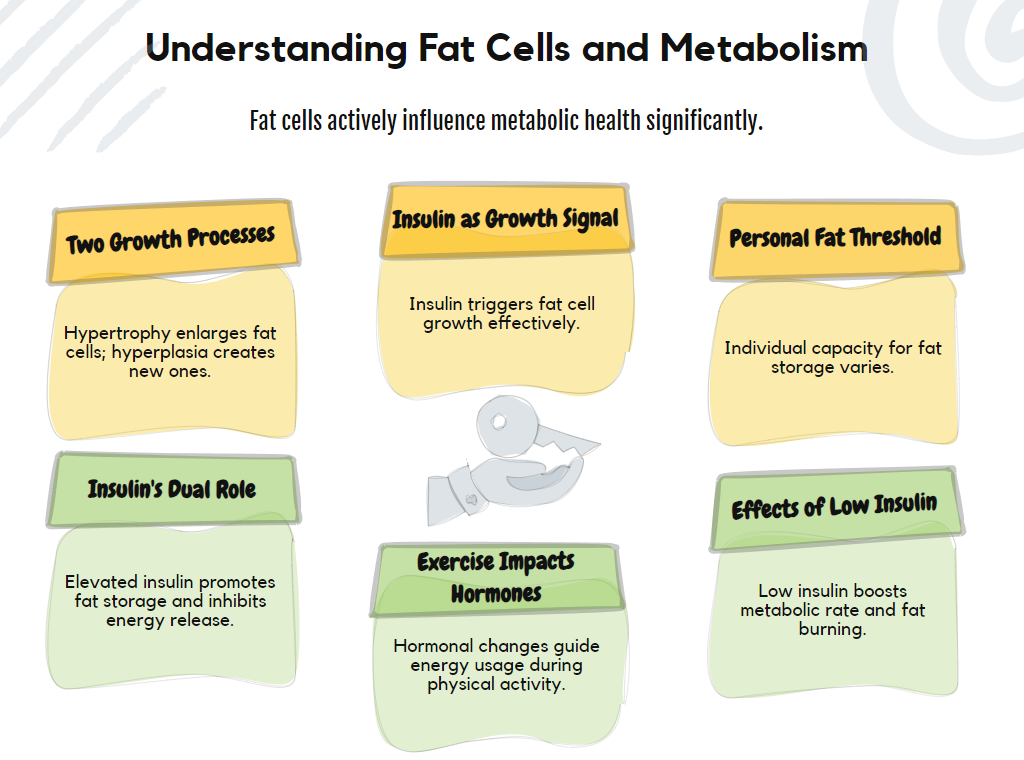
Why Fat Cells Grow and What Makes Them Shrink
Why Fat Cells Grow and What Makes Them Shrink
Your fat cells aren't just passive storage units. They're making decisions about your metabolic health right now.
Most people think about body fat as extra calories stored away. But the reality is far more complex and fascinating. How your body stores fat matters more than how much fat you store.
This distinction explains why some slim people develop type 2 diabetes while others can carry excess weight for decades with perfect metabolic health.
Two Ways Fat Cells Grow
When your body stores fat, it happens through one of two processes: hypertrophy or hyperplasia.
Hypertrophy occurs when existing fat cells grow larger. These cells can expand to an extraordinary degree.
Fat cells can grow to approximately 10-20 times their normal volume through hypertrophy, a capability unmatched by any other cell type in the human body.
Hyperplasia, on the other hand, involves creating new fat cells. These new cells remain small and metabolically healthy.
This distinction matters tremendously. Large, hypertrophic fat cells become dysfunctional, insulin resistant, and pro-inflammatory. They're the troublemakers in metabolic disease.
When fat cells undergo hypertrophy, they become insulin-resistant and pro-inflammatory as a survival mechanism. Ironically, the fat cell's attempt to preserve itself harms the rest of the body.
The Personal Fat Threshold
Everyone has what researchers call a "personal fat threshold." This isn't about how much total fat you can carry. It's about how much fat your cells can store before they start causing metabolic problems.
Think of it like a hotel with a fixed number of rooms. Some people have many small rooms (hyperplasia), and others have fewer, larger rooms (hypertrophy).
When the hotel reaches capacity, guests start sneaking out through windows. In your body, this means fat leaking into the bloodstream and accumulating in organs like the liver and pancreas.
This explains why some East Asians develop type 2 diabetes at BMIs that would be considered healthy in Caucasians. Their fat cells tend to be fewer but larger, reaching their threshold at lower body weights.
Women typically store more hyperplastic fat, especially in the hips and buttocks. This partly explains why women can have higher body fat percentages than men yet maintain better metabolic health.
The Growth Signal
What tells fat cells to grow? The answer isn't calories alone.
Research has consistently shown that insulin is the primary growth signal for fat cells. Without insulin, fat cells don't know what to do with the energy around them.
Dr. Bikman's research has shown that fat cells cannot grow unless insulin is elevated, making insulin control the key factor in managing fat storage.
This helps explain why some people can eat seemingly unlimited calories yet remain thin if their insulin levels stay low. Their fat cells aren't receiving the signal to store that energy.
In laboratory settings, fat cells in nutrient-rich environments won't grow until insulin is added to the mix. Only then do they begin expanding.
Insulin Does Two Things to Fat Cells
When insulin levels rise, two critical processes occur in fat cells.
First, insulin increases energy uptake. It escorts glucose into the cell and activates enzymes that convert that glucose into fat. It also enhances lipoprotein lipase expression, which pulls fat from the bloodstream into fat cells.
Second, insulin powerfully inhibits lipolysis, which causes fat cells to release stored energy. This double action creates the perfect environment for fat storage.
The "calories in, calories out" model is incomplete. Hormones determine what happens to those calories.
What Happens When Insulin Drops
When insulin levels fall, everything changes.
Metabolic rate increases by approximately 20%. Multiple studies, dating back to the early 1900s, documented this, when researchers observed that people with type 1 diabetes (who produce no insulin) had significantly elevated metabolic rates.
The body becomes extremely efficient at burning fat, so efficient that it produces ketones as a "release valve" for excess energy.
This creates a fascinating metabolic state where the body can waste calories through respiration and urine. These ketones represent energy that's being expelled rather than stored.
It's why people with type 1 diabetes who underdose their insulin can eat thousands of calories yet continue losing weight. Their bodies are in a state of unregulated energy wasting. This is dangerous and potentially fatal in that context, but it illustrates the powerful effect of low insulin on fat metabolism.
The Exercise Paradox
Consider what happens during exercise. Blood glucose often rises, yet fat cells don't absorb this glucose. Instead, they release fatty acids into the bloodstream.
How do fat cells "know" that muscles need energy? They don't directly sense the muscles working. They respond to hormonal signals, particularly falling insulin and rising catecholamines.
This demonstrates again that cells don't inherently know what to do with energy. They need hormonal signals to direct their behavior.
The Implications for Fat Loss
Understanding the biology of fat cells leads to several important insights about effective fat loss:
Fat loss requires low insulin. Without reducing insulin, fat cells remain locked in storage mode, regardless of calorie restriction.
Not all calorie restriction works equally well. Restricting calories while maintaining high insulin levels forces the body to reduce energy expenditure rather than access fat stores.
Ethnic differences matter. People with fewer, larger fat cells (like many East Asians) may need to maintain lower body fat percentages to achieve optimal metabolic health.
Exercise works primarily through hormonal effects. Its calorie-burning aspect is secondary to its ability to improve insulin sensitivity and reduce fasting insulin levels.
Beyond Weight Loss
This understanding of fat cell biology extends far beyond weight management. It explains why insulin resistance contributes to virtually every chronic disease of modern civilization.
When fat cells become insulin resistant through hypertrophy, they release inflammatory compounds and free fatty acids that damage other tissues. This creates a cascade of dysfunction throughout the body.
Focusing on insulin resistance rather than just body weight allows us to simultaneously address the root cause of multiple conditions.
The Path Forward
The science of fat cells offers a more nuanced understanding of metabolism than the simplistic "eat less, move more" paradigm.
It suggests that effective strategies for metabolic health should focus on:
1. Minimizing insulin spikes through appropriate food choices
2. Creating periods of low insulin through various fasting approaches
3. Improving insulin sensitivity through resistance training and other exercise
4. Recognizing individual differences in fat storage patterns
These insights don't invalidate the importance of energy balance. Rather, they explain why some approaches to creating energy deficits work better than others.
Fat cells aren't just passive repositories of excess energy. They're active endocrine organs that respond to specific signals. Understanding these signals gives us powerful tools to improve metabolic health.
The most effective approach to fat loss isn't about fighting your body but about speaking its hormonal language.
